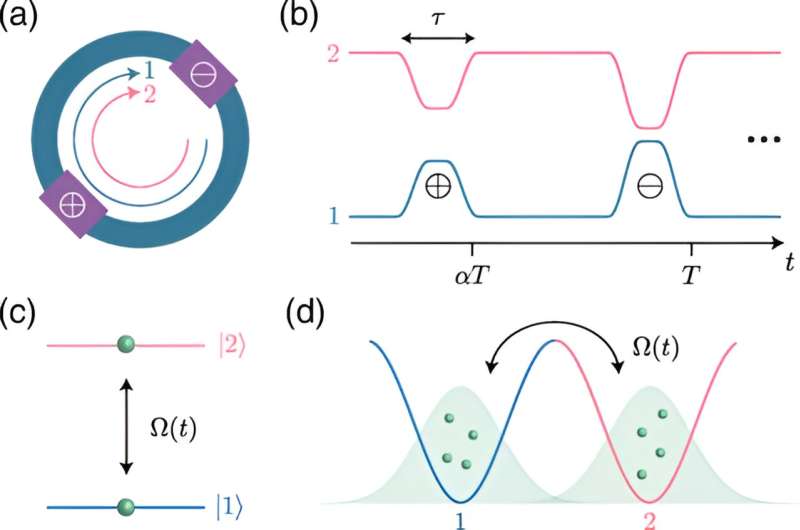![Possible realizations in optics and cold atomic gases: (a) Two modes in an optical ring cavity (1 and 2), repeatedly undergoing mixing operations ( ⊕ and ⊖ ) along the ring. These operations correspond to a coupling between the two polarization eigenmodes of the cavity, as realized by means of quarter-wave plates; see Eqs. (2) and (3). (b) Two optical waveguides (1 and 2) with modulated interwaveguide separation, realizing a “time-periodic” linear coupling Ω(t) between the two optical modes [Eq. (4)]. In both cases (a),(b), the “time” coordinate corresponds to the propagation direction [50, 89]. (c) Two-component BEC involving two atomic internal states and a time-dependent (microwave) coupling Ω(t). (d) Bosonic gas in a double-well potential, with a time-modulated tunneling strength Ω(t). Credit: PRX Quantum (2023). DOI: 10.1103/PRXQuantum.4.040327 Transcending nonlinear media by shaking](https://news.myworldfix.com/wp-content/uploads/2023/11/transcending-nonlinear.jpg)
Writing in PRX Quantum, Nathan Goldman and Lucila Peralta Gavensky (Science Faculty, ULB) and their colleagues introduce a general framework for modifying and controlling the nature of nonlinearities in a broad class of physical systems, including optical devices and quantum atomic gases.
Nature dictates how particles interact with one another. In a metal, for instance, electrons interact through Coulomb repulsion, as established by the electromagnetic forces acting between two negative charges. However, under special circumstances, the nature of interactions can be modified: in certain materials, electrons can effectively attract each other and form Cooper pairs, hence giving rise to superconductivity.
Similarly, in optics, effective photon-photon interactions can be induced by the medium through which light propagates. These so-called “optical nonlinearities” are at the core of numerous technologies that have revolutionized optical devices. Altogether, the modification of inter-particle interactions and nonlinearities can lead to fundamentally new phases of matter and concrete technological applications.
The authors introduce a general framework for modifying and controlling the nature of nonlinearities in a broad class of physical systems, including optical devices and quantum atomic gases. It is based on the concept of Floquet engineering, a strategy developed in atomic and solid-state physics, which consists of subjecting a system of interest to a time-periodic modulation in view of designing its properties at will.
Using a quantum theoretical approach, they show how a proper pulse sequence can generate new interaction processes between particles, ultimately giving rise to exotic and highly controllable nonlinearities. The authors then extend this strategy to synthetic lattice systems and demonstrate how such drive-induced interaction processes can stabilize newly ordered phases of matter through the spontaneous emergence of magnetic fluxes.
The general approach provided in this work opens a route for the engineering of unconventional optical nonlinearities in photonic devices and controllable drive-induced interactions in ultracold quantum matter.
More information:
N. Goldman et al, Floquet-Engineered Nonlinearities and Controllable Pair-Hopping Processes: From Optical Kerr Cavities to Correlated Quantum Matter, PRX Quantum (2023). DOI: 10.1103/PRXQuantum.4.040327
Provided by
Université libre de Bruxelles
Citation:
Transcending nonlinear media by shaking: A framework for controlling the nature of nonlinearities (2023, November 21)
retrieved 21 November 2023
from https://phys.org/news/2023-11-transcending-nonlinear-media-framework-nature.html
This document is subject to copyright. Apart from any fair dealing for the purpose of private study or research, no
part may be reproduced without the written permission. The content is provided for information purposes only.
